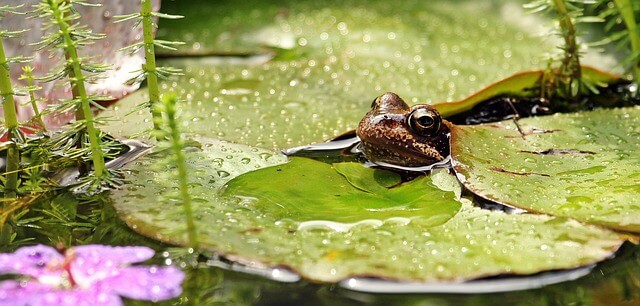Three Admiral butterflies fluttered past me while pruning back an evergreen indigenous shrub on Sunday. The presence of wildlife to any keen or aspiring gardener offers a great sense of achievement. Besides the positive impact to wildlife, attracting birds, bees, butterflies, small mammals and amphibians into your garden creates a haven of tranquility. As I sit here typing away I am conscious of the humming of bees over our lavender, the chirping of house martin chicks and common blue butterflies. A sign of being an environmentally responsible gardener.
Wildlife enthusiasts all agree that no matter how small a space you have, there are plants you can grow that will welcome wildlife – including aquatic plants!
How to attract wildlife to a small garden or patio
Add water – pond or water feature
Include plants with berries, seeds and nectar rich flowers – honey suckles are perfect for filling vertical space and their berries provide food for birds and buddleia
Add ground cover and shrubs – a place of protection and warmth for birds and mammals
A garden pond is a wonderful way of attracting many other types of wildlife – the wide range of creatures include frogs, newts, dragon flies, water skate and small mammals – bringing so much life and a whole new dimension to any size garden.
Ponds are particularly important for providing a home for frogs, toads and newts. In turn they offer a natural means of pest control helping to maintain a healthy balance in the garden. Amphibians prefer still water leaving water in Autumn to hibernate in ground cover, log piles or pulses of fallen leaves.
The common frog will eat slugs, caterpillars, flies and mosquitoes. 
What is needed for a successful wildlife pond
A fact about ponds is that they support two thirds of our native freshwater species of plants, invertebrates, mammals and amphibians.
There are a few requirements to ensure your pond can support wildlife
- a beached area to at least a third of the circumference of the pond – do this by either grading the soil under the pond liner or adding stones, pebbles or washed grit above the pond liner. If you are concerned about damaging your pond liner, remember you can add a layer of protective underlay both above and below the pond liner.
- add a semi submerged rock or feature for birds to perch on while taking a drink
- include cover for small creatures by allowing for sufficient space around the edge of a pond for planting. A dense amount of planting around and within the pond as well as a pile of old logs or sticks offers a place for small creatures to safely hide from predators and extreme weather conditions.
Marginals plants are great for attracting insects but also for providing cover to frogs, newts, birds and even small mammals. Marginals help to merge land with water and will tolerate a rise or fall in water level.
Adding deep water plants will help to keep the water oxygenated and healthy. An example is the well known water lily whose leaves over cover as well as a landing pad for insects and frogs.
Best planted in aquatic baskets.
On land the best cover is from shrubs and hedges.
Create the right environment and wildlife will be drawn into garden.
What is a wildlife pond vs fish pond?
A wildlife pond is one which is likely to have the following visitors in abundance – water boatman, pond skaters, pond snails, hedgehogs, birds of the area, water is essential for all creatures.
Mini barrel pond – arrange different levels of rocks, pebbles or clay pots placed at different levels around outside of barrel to assist small creatures visiting your barrel pond.
Tip: Don’t keep fish that are likely to eat visiting wildlife. In dry weather top up with water from rain butt.





